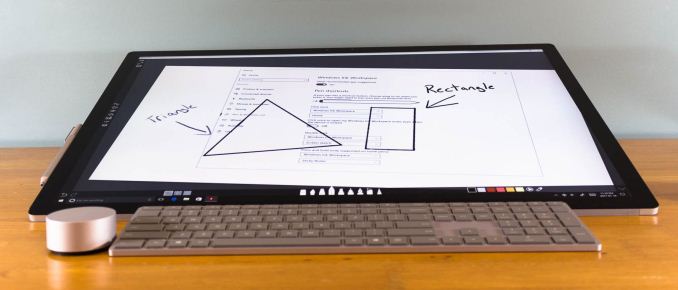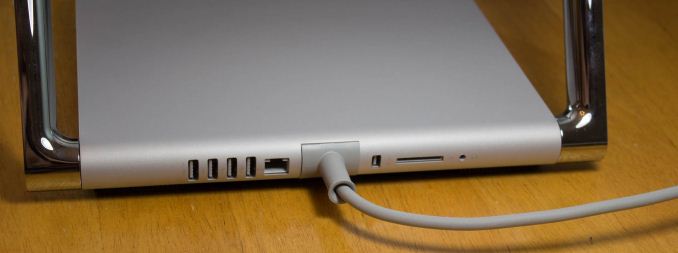The Microsoft Surface Studio Review
by Brett Howse on January 20, 2017 8:00 AM EST- Posted in
- Desktop
- Microsoft
- Surface
- Surface Studio
Design and the Zero-Gravity Hinge
Microsoft has built a brand around Surface, and that’s not an easy thing to accomplish. The Surface Studio fits in very well with the design ethos of the rest of the Surface lineup, and there has been quite a bit of attention to details paid in the creation of their first desktop computer. The first, and most obvious, is the finish, which matches perfectly with the other Surface devices, despite being made from aluminum rather than the magnesium alloy used on the portable products.
The 3:2 aspect ratio of the Surface Studio display is now a hallmark of the Surface brand (outside of Surface Hub), and having a taller display makes doing most tasks on a desktop a more pleasant experience. The increased surface area can’t be forgotten either, with the Surface Studio offering 17% more screen real estate than what's arguably the Studio's closest competitor, the 27-inch iMac, which amounts to an additional 54 square inches of display. Widescreen at 16:9 has never been a great aspect ratio for PC tasks, but the proliferation of high definition television seems to have moved the entire industry this way in an effort to save costs. When looking at the price of the Surface Studio, it’s important to remember that the entire display industry has moved to 16:9 as a standard, which impacts the entire supply chain and tooling required. Moving to an aspect ratio outside of 16:9 has large cost implications, but the end results are certainly worth it. Hopefully we will see a few other manufacturers use this as a means to source displays like this, much like the Surface Pro 3 and Pro 4 have ushered in more 3:2 devices at that much smaller size. And speaking of attention to detail, the Surface Studio is actually 28.125-inches diagonal, and as we'll see in a bit, that last 0.125-inches is very important.
It seems with Surface, Microsoft always wants to have a trick up their sleeve. With the original Surface RT and Surface Pro, it was the kickstand, which has been adopted by quite a few manufacturers for their own device since it works so well. When they launched their first laptop, the Surface Book, it was the muscle wire locking mechanism to remove the display from the base, as well as the dynamic fulcrum hinge to make the top-heavy laptop more stable. With the Surface Studio, the zero-gravity hinge is most definitely its signature design feature.
With two chrome arms flanking the base, the Surface Studio can almost effortlessly be folded down into a drafting table. The hinge mechanism provides a perfect counterbalance to the weight of the display, making it feel like it has almost no weight at all. The hinge is a single movement as well, so you don’t tip and fold the screen, but instead folding the screen also causes it to move down. While this does limit the functionality somewhat – for instance, you can't move the screen half way down and then fold it up straight again – the result is truly a wonderful design which almost needs to be seen in person.
Because you can’t tip the screen without folding it, once you stop at any angle, the screen is very solid to work with, although it is the most secure when folded all the way down to the 20° angle. You would think a large desktop display would not be ideal to use with touch, but the Surface Studio zero-gravity hinge invites you to be more interactive with it, by keeping the display close and folding it down when needed. More traditional all-in-one computers with a touch screen are nowhere near as easy to work with, since holding your arm in dead-air can be tiring, but the folded display doesn’t suffer from these burdens.
The PC base also exudes Surface quality, with the signature color, and cooling vents all the way around in the same fashion as the Surface Pro and Surface Book. The PC base can be disassembled from the bottom if required, for access to the storage and fans, but the remainder of the system is soldered to the board as you would expect in a small form factor device like this. The most frustrating part of the Surface Studio base is that all the inputs and outputs are on the rear of the device, so connecting something over USB, or inserting a SD card into the PC, is not as simple as it should be. This is a form over function decision, and it would be nice to see some of the ports offered at least on the side of the base to make it a bit easier to access.
The desktop PC market has not been as exciting to watch as the smaller and more portable laptops and tablets, but the Surface Studio sets a new high mark for desktop PC design and looks. Some of the decisions are form over function, but the majority of the design decisions actually improve the user experience. The zero-gravity hinge is a masterpiece of engineering, with such a smooth action that it really does feel like the display has no mass at all.













197 Comments
View All Comments
fanofanand - Monday, January 23, 2017 - link
I got screwed on the RRoD twice. I haven't bought a Microsoft product since, which isn't easy in this day and age.batteries4ever - Monday, January 23, 2017 - link
Fascinating.... I had major problems with a Dell 7275 tablet before... all of which were solved after switching to the Surface Pro 4, which I would gladly recommend to everybody, expect maybe heavy duty users..... Also hooking the thing up to a beamer "just works" . The only problem I had turned out to be a connector to a monitor causing frequent tries to switch between 1 and 2 monitors which locked up my Surface.damianrobertjones - Friday, January 20, 2017 - link
We have a whole load of SP3 and SSP4 device, in work, so we're aware of the various aspects of the hardware and software. So far, other than a SP3 wireless card dropping from the machine, we've experienced little to no issues. A few black screens that were resolved with the power button+volume button but that's about it.I always clean refresh and immediately update to the latest build etc.
piroroadkill - Friday, January 20, 2017 - link
What people really want to know is: when I can buy just that screen?unrulycow - Friday, January 20, 2017 - link
+1lilmoe - Friday, January 20, 2017 - link
AHHHHH, I just love that aspect ratio.macmhathain - Saturday, June 17, 2017 - link
so much better than 16:9 - which is horrible for everything except watching wide screen movies. Who does that on their computer anymore? and especially bad for word processing or for the web!Picobozo - Friday, January 20, 2017 - link
You mean the Dell Canvas?http://www.theverge.com/2017/1/5/14128434/dells-ca...
tamalero - Sunday, January 22, 2017 - link
The resolution is too low imho.piroroadkill - Thursday, January 26, 2017 - link
But that's just a run of the mill 27" 16:9 2560×1440 monitor, nothing special. The resolution, 192 DPI and aspect ratio of the Surface Studio are what make it special.